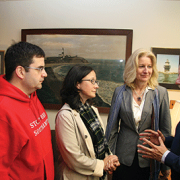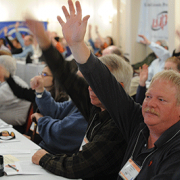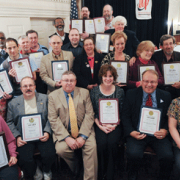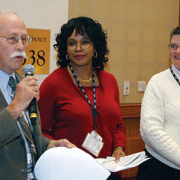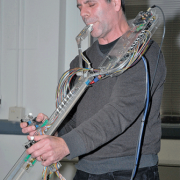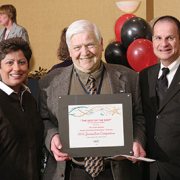|
UUP advocates had a major challenge to begin with. It came in the form of $152 million in additional budget cuts to SUNY and the proposed so-called Public Higher Education Empowerment and Innovation Act (PHEEIA). Then the governor introduced a furlough plan affecting most UUP members. The furlough was part of a weekly budget extender bill in early May that would keep state government operating in lieu of a new state budget. Faced with the specter of a state government shutdown if they failed to act, the Legislature reluctantly approved the bill and the furloughs. Within hours of the bill’s passage, UUP moved to stop the furloughs. The union—along with PEF, CSEA and Professional Staff Congress/CUNY—filed a lawsuit May 11 in U.S. District Court in Albany charging the furloughs were unconstitutional because they violate the article barring states from passing legislation that impairs contract obligations. UUP’s lawsuit included a temporary restraining order to block the furloughs. Little more than 24 hours later, the judge granted the restraining order, preventing the furloughs from going forward pending a final ruling on the lawsuit. Delegates to UUP’s Spring Delegate Assembly cheered when UUP President Phillip Smith held up a copy of the May 13 edition of the Albany Times Union that bore the headline, “100,000 to stay on the job.” “The fact that the judge ruled for the temporary restraining order so quickly is a good sign for us,” Smith told the delegates, reflecting optimism that UUP would prevail in court. That final ruling had not been made as The Voice went to press. Smith pledged that whatever happens, the union would take no action that would give the governor or the SUNY chancellor control of their contract. “Any plan that doesn’t meet our needs will be rejected. If it does meet our needs, it will go to the full membership for ratification,” Smith vowed. Most of UUP’s efforts to protect its members and SUNY took place not in the judicial arena, but in the legislative one. Members flocked to Albany for a series of advocacy days throughout March, April and May, meeting with state lawmakers to express their concerns and to seek their support. “I don’t know how SUNY can take another $152 million cut,” Outreach Committee Co-chair Glenn McNitt of New Paltz told Sen. Kemp Hannon (R-Garden City). “It would demolish it.” Abe Gerecht of Brooklyn HSC stressed the importance of funding SUNY when he told Assemblywoman Linda Rosenthal (D-Manhattan), “Education is a necessity, not an expense.” Lawmakers were told the prior budget cuts had already taken their toll on SUNY in the form of fewer course offerings, crowded classrooms and delayed graduations. “Campuses have come to the point where we have 150 students in an English class,” Oneonta Chapter President William Simons told Assemblywoman Barbara Clark (D-Queens Village). Clark also heard UUP’s appeal to save the New York State Theatre Institute, which is in danger of losing its state funding. “The theater institute is in peril,” warned Linda O’Malley of NYSTI. “We’re primarily an educational institution. Arts education is vitally important.” UUP advocates also continued waging the fight against PHEEIA, even challenging one of its chief backers, Assemblyman Mark Schroeder (D-Buffalo). UUP Vice President for Academics Frederick Floss responded to Schroeder’s claim that opposing the bill hinders job growth in western New York. “UUP is not hindering job growth,” Floss said. “This bill says you’re going to privatize SUNY and take away all your (the Legislature’s) oversight power.” PHEEIA figured prominently in UUP’s fight against the sudden decision to close Stony Brook’s Southampton campus. Just days after the Stony Brook administration announced the controversial closure, UUP’s Stony Brook Chapter forged a coalition with Southampton students. The result: Nearly 100 students joined with UUP advocates to meet with lawmakers on the issue. The UUP advocates served as mentors for the students, providing them guidance on advocacy prior to their visits. Stony Brook Chapter President Arthur Shertzer asserted that if PHEEIA passed—removing legislative oversight over SUNY—more such unilateral closures could occur. “What’s to stop SUNY from closing other schools?” Shertzer asked during a meeting with state Assemblyman Fred Thiele (I-Bridgehampton). “The chancellor and the SUNY Board of Trustees want to run SUNY without the Legislature.” In another cooperative advocacy effort with students, about 30 UUP members enlisted the help of more than 100 students from SUNY’s Equal Opportunity Program (EOP) and Equal Opportunity Centers (EOC) to jointly urge lawmakers to fund the programs. “We’ve got to send the message that these programs are critical,” Darleyne Mayers of Farmingdale told Sen. Carl Marcellino (R-Oyster Bay). “We can’t allow state cuts to kill the academic and economic dreams of these students.” Farmingdale EOP student Patrice Glenn, a single mom, said she wouldn’t be studying to become a licensed practical nurse at Farmingdale without the EOP. The EOP provides academic support and financial aid to low-income students who want to attend college. EOCs help prepare students for college or vocational training programs. But the programs face reductions as part of proposed state budget cuts to SUNY. Students like UAlbany’s Sheryl Berkow shared their success stories. “It’s sad to think that something like education, our dream, may be taken from us,” Berkow told an aide for Republican Assemblyman George Amedore Jr. (R-Amsterdam). — Donald Feldstein |
Author Archives: United University Professions Admin
2010 Spring DA – Fired up: Delegates ready to fight attacks; elect officers, board
|
Delegates to the 2010 Spring Delegate Assembly in Albany covered a wide range of union business during their policymaking convention May 14-15. They elected officers and Executive Board members, debated policy, adopted the union’s 2010-2011 budget, attended meetings, wrote and faxed lawmakers to support SUNY, listened to committee and officers’ reports, and honored their colleagues for outstanding newsletters and websites. They also heard about the mounting challenges confronting public education in general and SUNY in particular, and heard UUP President Phillip Smith vow to reject any scheme to weaken the union’s negotiated contract. Read on for highlights. UUP President Phillip Smith used his State of the Union address to get delegates to the 2010 Spring Delegate Assembly fired up about furloughs, the Public Higher Education Empowerment and Innovation Act (PHEEIA), the SUNY Strategic Plan and myriad other attacks raining down on public higher education. Smith outlined SUNY Chancellor Nancy Zimpher’s step-by-step plan to wrest power over the University from lawmakers and the public by pushing for passage of PHEEIA, and criticized her strategic plan for failing to promote research and learning. “This is all about power,” Smith said. “This is not about SUNY. It’s not about students. And it’s certainly not about us.” He vowed that “UUP will not be brought to its knees” by SUNY administrators or state politicians hell-bent on destroying the union and privatizing the University. Likening UUP’s situation to that of Henri Charriére, played by Steve McQueen in the movie Papillon, Smith said Charriére is a convict whose spirit and courage sustained him through two years of solitary confinement. “Once outside, hunched over and nearly blind, he faced the administration building where the warden and officers of the prison resided. In a quivering voice, he said, ‘I’m still here, you bastards.’” “We must activate the membership to turn things around,” Smith added. “And, by God, we can say: You bastards, we’re still here.” Smith called on the nearly 300 delegates in attendance to remain diligent in educating students, community members, business owners and lawmakers on the dangers of PHEEIA and other privatization schemes, and to keep UUPers abreast of anti-union tactics designed to pit rank-and-file members against union leaders. Delegates responded by writing letters and sending hundreds of computer faxes to lawmakers from the union’s Political Action Center, and adopted a 10-committee resolution calling for a detailed action plan to combat PHEEIA, the strategic plan, and SUNY Board of Trustees’ changes in general education requirements. “Once more, it’s up to us,” Smith said. “We are making our intellect and our influence count. With your support, involvement and advocacy, we will continue the fight, so that SUNY will remain open to families of low and moderate income.” DA delegates re-elected three statewide officers and three Executive Board members. Two first-time board members were also elected to two-year terms during the two-day convention. Vice President for Academics Frederick Floss defeated challenger Patricia Bentley of Plattsburgh, 157-116. Vice President for Professionals John Marino and Treasurer Rowena Blackman-Stroud were re-elected without opposition. Returned to the statewide Executive Board were Jamie Dangler of Cortland, who was challenged by M. Steve Pendleton of Buffalo Center, 175-102; Philippe Abraham of Albany, who was challenged by fellow incumbent Carolyn Kube of Stony Brook HSC, 145-128; and Kube, who later won re-election against challenger Raymond Dannenhoffer of Buffalo HSC, 145-125. Newly elected to the board was Ray Gleason of Alfred, who ran unopposed in his bid for the seat representing technology colleges. James Engle of Morrisville was successful in his bid in a runoff election with Jacqualine Berger of Empire State College, 155-113. The first contest included incumbent Peter D.G. Brown of New Paltz, whose 88 votes were not enough to get him in the runoff race between Engle, 96, and Berger, 91. The new leaders take office June 1. A number of resolutions were debated during the convention. Delegates: • Asked UUP to recognize people with disabilities, and to work to ensure inclusive campuses that provide quality experiences and work lives for members. • Condemned Arizona Immigration Law SB1070, which requires police to determine the immigration status of a person they believe to be in the U.S. unlawfully. Delegates also directed UUP to send letters of condemnation to all appropriate parties. In a separate resolution, delegates directed the Committee on Latino Affairs to send a letter asking the Executive Board to consider supporting legal action in reference to the Arizona Immigration Law. • Adopted a resolution to condemn any institution of higher education that “restricts or redacts personal, intellectual or academic freedoms under the guise of religious intolerance.” The resolution stems from Marquette University’s decision to rescind a job offer allegedly because the candidate is a lesbian. Delegates also directed UUP to send a letters of condemnation to the president and board of the Milwaukee-based Catholic university. • Supported the call for a national day of action against the privatization of public education, and asked the Executive Board to promote similar resolutions with AFT and NYSUT. UUP chapters were also encouraged to work with student, civic and labor groups to take action on campuses and in communities on that date. • Urged UUP to work with AFT and NYSUT to support the campaign for a national Cesar Chavez holiday. • Stood for a moment of silence in honor of civil rights leaders Benjamin Hooks, director of the Federal Communications Commission; Dorothy Height, CEO of the National Council of Negro Women; and singer Lena Horne, the first African American female to entertain the troops during World War II. • Recognized by acclamation the contributions of outgoing Executive Board members Raul Huerta of Morrisville and Brown of New Paltz. The annual Basket Bazaar fundraiser and a raffle for a mountain bike netted a combined $2,175 for the UUP College Scholarship Fund, which each year gives a one-time, $2,000 scholarship to up to four SUNY undergraduates. The full DA report can be found at www.uupinfo.org under DA/Conferences. — Karen L. Mattison |
Members awarded for journalistic efforts
|
Thirteen chapters and UUP’s retiree group were recognized for their outstanding communications efforts during the 10th annual UUP Journalism Contest. The competition is supervised by the UUP Communications Department and is judged by professional journalists from the Capital District. “Our chapters do an outstanding job of communicating with members,” UUP President Phillip Smith said when honoring this year’s recipients at the 2010 Spring DA in Albany. “I am proud to recognize your selfless dedication to the union, the University and your colleagues.” Newsletters, feature articles, editorials, photographs and websites were judged in three classes: Class I, UUP membership under 500; Class II, membership from 500-1,000; and Class III, membership over 1,000. Earning this year’s awards were: GENERAL EXCELLENCE Class I Best in Class: Delhi Voice, John Taylor, editor; and Honorable Mention: Cobleskill Unity, Jennifer Schorf, editor. Class II Best in Class: Cortland Cause, Karla Alwes, editor; Award of Merit (tie): Oneonta Sentinel, Jill Attanasio, editor, and Oswego In Touch, Don Masterson, editor; and Honorable Mention: Farmingdale Unifier, Margaret Porciello, editor. Class III Best in Class: Binghamton Connection, George McKee, editor; and Award of Merit: The Active Retiree, Judith Wishnia of Stony Brook, editor. BEST FEATURE STORY Class II Best in Class: Cortland Cause, “Larry Ashley: The Cortland Cause,” Alwes, writer. Class III Best in Class: The Active Retiree, “All aboard: Travel guru rides the rail across America,” Malcolm Nelson of Fredonia, writer; and Award of Merit: Binghamton Connection, “Scoring a good education in Kenya,” James Dix, writer. BEST EDITORIAL/COLUMN Class I Best in Class: Delhi Voice, “The Wrong Fight,” by John Taylor. Class II Best in Class: Oswego In Touch, “Thinking the University in a time of crisis,” Stephen Rosow, writer; Award of Merit: Plattsburgh The Union News, “Difficult times ahead,” David Curry, writer; and Honorable Mention: Cortland Cause, “DSI for part-timers: Small gain, big disappointment,” Jamie Dangler, writer. Class III Best in Class: The Active Retiree, “We must fight for the America we deserve,” Wishnia, writer; Award of Merit (tie): Binghamton Connection, “A new president: What we might look for,” Peter Knuepfer, writer, and Upstate Medical University The Advisor, “Should The Advisor go paperless,” Colin Massulik, writer; and Honorable Mention: Stony Brook Insight, “Within Stony Brook University,” Edward O’Connell, writer. BEST ART/PHOTO Class II Best in Class: Cortland Cause, “Welcome back picnic,” Brain Tappen of Upstate Medical, photographer. Class III Best in Class: Upstate Medical The Advisor, “General membership meeting,” Tappen, photographer. BEST WEBSITE Class II Best in Class: Brockport, Kristen Adduci, webmaster; Award of Merit: Oswego, Maureen Curtin, webmaster; and Honorable Mention: Farmingdale, Margaret Porciello, webmaster. Class III Best in Class: Stony Brook, Pamela Wolfskill, webmaster; Award of Merit: Upstate Medical, Massulik, webmaster; and Honorable Mention (tie): Stony Brook HSC, Bruce Kube, webmaster, and Albany, Michael Knee, webmaster. Judges were Karen O’Brien, a former Albany Times Union reporter/editor; Peter Boespflug, former NYSUT communications professional; and Kevin Mattison, editor, The Recorder, in Amsterdam, N.Y. — Karen L. Mattison |
2010 NYSUT Representative Assembly; Higher ed supported: UUPers help define excellence at the 2010 RA
|
When it came time to act, UUPers at the NYSUT Representative Assembly stood up and called on NYSUT to publicly denounce continued state cuts to public higher education and SUNY’s Public Higher Education Empowerment and Innovation Act (PHEEIA). When NYSUT President Richard Iannuzzi asked delegates to call state senators to oppose raising the cap on charter schools, UUPers were quick to pull out their cell phones and let their fingers do the walking. And after United Mine Workers of America President Cecil Roberts finished a fiery speech about April’s tragic West Virginia mine explosion and the need for job safety and union solidarity, UUPers helped raise $15,000 to aid the families of the 29 miners who died in the disaster. That’s how UUP members defined excellence at NYSUT’s 38th annual RA, held April 29-May 1 in Washington, D.C. More than 100 UUPers from across the state joined nearly 2,000 of their NYSUT sisters and brothers in the nation’s capital to make their voices heard. The RA’s theme was “Defining Excellence,” and UUPers achieved that by winning unanimous approval on resolutions that put NYSUT on record against further cuts to SUNY, CUNY and community colleges, and PHEEIA. The resolutions require NYSUT officers to recommend that its endorsement committees ignore elected officials and candidates who support or vote for PHEEIA or higher ed budget cuts. “This is something that needed to be done,” said UUP President Phillip Smith. “We are gratified to have the backing of our 600,000 NYSUT brothers and sisters on these important issues.” Two other UUP-sponsored resolutions were approved, dealing with providing parity in funding mechanisms to CUNY and SUNY, and opposition to the war in Afghanistan. Necessary solidarity NYSUT officers offered solid support for UUP and NYSUT’s higher ed affiliates, and urged them to keep fighting. “When you say you’re represented by 600,000,” Iannuzzi said of legislators, “they’ll know you mean it.” “I will be out there to fight your fight because I believe in higher education,” said NYSUT Vice President Kathleen Donahue. Join a union! Roberts delivered the session’s most impassioned moments. In a May 1 speech that sounded much like a sermon, he vehemently attacked Massey Energy for failing to improve safety conditions in its underground mines before the April 5 explosion that killed 29 West Virginia miners. He demanded that safety laws for workers be enacted and enforced by the government. Moved by Roberts’ eloquence, UUPers leaped to their feet more than a half dozen times during his 20-minute oration, cheering with other delegates as he stressed—and sometimes shouted—the importance of union activism and solidarity. “What every worker in this country needs whether they’re a school teacher, a professor, a coal miner or a construction worker, is the right to be able to join a union without interference from any boss or any CEO,” he said. After Iannuzzi presented Roberts a NYSUT check for $10,000 for disaster relief, delegates dug deep and raised another $15,000 in 15 minutes. Roberts said the money will go to the families of the mining accident victims. Senators speak UUPers also listened to speeches by Sens. Chuck Schumer and Kristen Gillibrand, who promised to work to pass the $23 billion Keep our Educators Working Act, which would send $1.4 billion to New York to reduce budget cuts and avert teacher layoffs. Iannuzzi and NYSUT officers, U.S. Congressman William Owens (D-Plattsburgh), AFT President Randi Weingarten, NEA President Dennis VanRoekel and New York state AFL-CIO President Denis Hughes were among other speakers who addressed convention delegates. RA delegates also approved a far-reaching set of principals to help put educators at the forefront of defining excellence from pre-kindergarten to higher ed. For higher education, the NYSUT principals stipulate that students “must be guaranteed” access to quality higher education. To achieve that, public funds must support higher ed. Also a necessity: investing in permanent, full-time faculty and staff, and ensuring faculty and staff the rights of academic freedom, shared governance, peer review and collective bargaining. — Michael Lisi |
Member spotlight: Buff State UUPer makes his own kind of music
|
At first glance, UUPer José “Tomas” Henriques’ double controller looks like a cross between some kind of bizarre metal detector and something “Star Wars” hero Luke Skywalker might use to fight the Galactic Empire. But the futuristic-looking apparatus doesn’t blast Imperial Stormtroopers or locate buried treasure—although it did end up making some cash for the Buffalo State assistant professor. The double controller, invented by Henriques, is a musical instrument, and a rather unique one at that. It was a hit at Georgia Tech’s prestigious 2010 Margaret Guthman New Musical Instrument Competition, held in Atlanta in March. Henriques’ creation—an electric, trombone-style instrument that produces sound by sliding and twisting two hand controllers on either side of its aluminum frame—took top honors in the event, beating out 26 entries from six countries. He won a $10,000 award for placing first. You can see his Guthman performance online at www.youtube.com/watch?v=0sX4Dleqz_0. “I envisioned it as an instrument with a unique sound, but not something too complex to have a personality,” Henriques said. Measuring nearly two feet long, the double controller produces a majestic, metallic and almost orchestral sound that’s both soothing and unsettling at times. The instrument has a musical range comparable to a piano; it can hit very low and very high notes. Made of Plexiglas, aluminum and circuitry, the double controller rests on the shoulder and works a little like a trombone. That’s not so surprising when you consider that Henriques, a composer, is an accomplished slide trombonist. But instead of one slide, there are two, which glide on thin rods on each side of the instrument; the slides help shape its resonant sound. The controllers are outfitted with a small joystick and 13 buttons. They also move, allowing Henriques to add vibrato and extend the notes he plays. Sound is created when Henriques blows into a mouthpiece attached to the instrument. But it’s the pressure of the air—not the air itself—that makes the sound. “The air goes to an air pressure sensor,” he said. “The sensor senses if air is being blown hard or soft and that’s used to control volume and how dull or bright the sound is.” The instrument’s brain is connected to a computer that analyzes and processes the data from the mouthpiece sensors. The computer instantaneously converts the data into sound, which can be manipulated by Henriques. “Because the sounds are all electric, you can make it sound like anything you want,” he explained. “That’s the beauty of it. I can make it sound like a flute or even someone speaking if I want to.” Henriques built the double controller last year, but he’s already planning modifications, like a version with a built-in amplifier and speaker. He may already have a taker. The principal trombone player for the Buffalo Philharmonic Orchestra has asked Henriques to build him a double controller. And several Buffalo area jazz players that have heard the instrument have given their thumbs up. “I’m planning on performing with it, but I’m not proficient right now,” Henriques said. “I’ve spent my time perfecting the software, so I’ve had little time to actually learn the instrument.” — Michael Lisi |
Retiree newsletter wins big
|
For the second time in six years, UUP’s newsletter for its more than 3,400 retiree members earned the Ted Bleecker “Best of the Best” Award in the annual NYSUT Journalism Contest run by New York Teacher. In all, The Active Retiree won five awards for newsletters produced in 2009. The Bleecker award is given to the publication—in-service or retiree, 10 members or 10,000—that the judges believe is top-notch in every way. Judges look for quality writing, editing, photography and design. The award is named after the late Ted Bleecker, editor-in-chief of New York Teacher for more than two decades. All articles are written and edited by UUP retirees. Layout and some photography is provided by Publications Specialist Karen Mattison. The Active Retiree, which first earned the Bleecker award in 2004, drew high praise from the judges: “Absolutely the best! Thorough attention to detail in design, visuals and an excellent variety of story content. On every count—content, layout, writing, photos—this newsletter stands out. A model of what a newsletter should be.” The Active Retiree also won top honors for Best Newsletter for publications with a circulation of more than 1,000. The winning June 2009 issue included articles on the state Alliance for Retired Americans conference and NYSUT Representative Assembly highlights, as well as regional meeting coverage and recognition of two award-winning UUP retirees. “This is the way it’s done,” wrote contest judges. “Great publication, filled with informative and interesting articles ranging from topics of interest for retirees to general interest articles. The writing and layout exude professional quality.” Individual awards went to: • Malcolm Nelson of Fredonia, who earned first-place honors for Best Feature Story for his April 2009 article “All aboard,” about his cross-country train trip to visit friends in Illinois, California and Oregon. “This was a delightful, informative journey through America on the rails,” according to the judges. “Beautiful imagery. Nicely done.” • Donald Cohen of Albany, who picked up a first-place award for Best News Story for his April 2009 article “Elder abuse under review.” The judges had this to say: “Excellent article on an often overlooked topic in today’s society. Thoroughly reported with important details in breakout points. Excellent!” • COARM Chair Judith Wishnia of Stony Brook, who received an Award of Merit for Best Editorial for her June 2009 commentary “Labor left out of social history.” “A direct and beautifully written column on the importance of unions in U.S. history and why they are still needed today,” wrote the judges. |
March 2010

To the point: Don’t corporatize SUNY
|
The Public Higher Education Empowerment and Innovation Act (PHEEIA) proposed by Gov. David Paterson in his Executive Budget has become a Trojan horse for those who wish to move SUNY closer to a private university system. As I’ve said before, we must remember that SUNY was established 60 years ago to be a public system of higher education that would ensure access to an affordable and high-quality education for every New York resident. The governor’s proposals will have serious, perhaps unintended, consequences. PHEEIA would provide SUNY with autonomy to set tuition, lease state-owned campus properties, enter into contracts for services, and establish public/private joint ventures and partnerships. Unfortunately, the governor’s proposals shift the discussion of priorities away from access and quality to concepts such as economic development and public/private relationships. We know, from hard experience, that the corporatization of our public university has already produced negative consequences. While SUNY has moved public discourse toward concepts such as flexibility, thousands of qualified high school graduates were denied admission this year and there is every reason to believe that many times that number will be denied admission next fall. The contention that flexibility will produce 10,000 new campus jobs and more than 64,000 construction jobs at SUNY’s university centers and at Upstate and Downstate medical centers seems unrealistic, at the very least. I can’t say where SUNY will come up with $8.5 billion to fund capital construction costs at the university centers—building that’s to spur all those construction jobs. Despite our repeated requests, SUNY has never offered any analysis to show why it needs this authority, nor has it provided any back-up to the highly unrealistic financial assertions made in its various supported documents. The governor’s proposals also repeal provisions of law requiring pre-approval of SUNY contracts by the attorney general and the state comptroller, and substitutes post-audits for the pre-contractual approvals required under current statute. But post- audits are infrequent, often performed years after contracts have been executed and funds expended. In the case of highly decentralized institutions, such as the University, it would be unrealistic to expect post audits to provide adequate oversight. Let me be clear: We do not oppose SUNY entering into contracts for goods without pre-approvals from the state comptroller and attorney general. However, we do oppose allowing SUNY to enter into contracts for services without state approval. The potential of outsourcing would significantly increase by relaxing those rules, leaving UUP powerless to stop those contracts before they were executed. By removing oversight by the Legislature, comptroller and attorney general, the governor extends to SUNY’s public institutions the unrestricted freedom of a private university, or for that matter, its own research foundation. There will be no accountability for SUNY spending decisions and the transparency of SUNY operations will be virtually eliminated. This proposal is clearly anti-labor. Regardless of how comprehensive and well-drafted employee language might be, our attorneys have advised us that the enforceability of any language governing the actions of private employers cannot be sufficiently protective of the rights of public employees. PHEEIA is no panacea. As our statewide awareness campaign states, Don’t be fooled by the Act. |
United front: UUPers, students combine to stand up for the University
|
For months, UUP leaders have emphasized the importance of coalition building to fight $152 million in additional budget cuts to SUNY and the proposed so-called Public Higher Education Empowerment and Innovation Act (PHEEIA). That directive was carried to the ultimate March 9, when nearly 100 UUPers—armed with placards stating “Stand Up for SUNY” and “SOS: Save Our SUNY”—joined with students and faculty from SUNY and CUNY and the New York Public Interest Research Group for Student/Faculty Higher Education Action Day in Albany. UUP President Phillip Smith addressed the crowd of about 400 who assembled for an indoor rally prior to a series of visits to nearly every state lawmaker. “There are three things you’ve got to remember. Tell legislators to stop the budget cuts, restore the funding, and stop looking at students as cash machines,” he said to loud applause during the indoor rally. His call to restore funding referred to the $410 million already cut from SUNY in the last two years. Smith also zeroed in on PHEEIA, saying it “would make public higher education unaffordable for thousands of students by allowing campuses to boost tuition without legislative approval. It would allow SUNY tuition costs to skyrocket,” he said. Senate Higher Education Committee Chair Toby Ann Stavisky (D-Whitestone) expressed her strong support. “We’ve had over half a billion dollars in cuts to public higher education, and that’s got to stop. We need to stand together and say ‘Enough is enough,’” she said as the audience cheered. Faculty and students traveled in groups to jointly take their concerns directly to state lawmakers, including three dozen UUPers who made their debut as Albany advocates. Among them: Brian Posthauer, an Educational?Opportunity Program (EOP) counselor at Plattsburgh, who told Assemblyman James Conte (R-Huntington Station) that budget cuts have seriously affected EOP by reducing the numbers of students they can serve. As students described the problems budget cuts are causing them, UUPer Mary Kay Skrabalak of UAlbany shared a personal note. “When my daughter at Oneonta says she can’t get into two of her courses, that’s frustrating,” she said. Two first-time advocates from Cortland—Mary Toti and Vicki Hess—were encouraged by comments from Assemblyman Thomas Alfano (R-North Valley Stream). “We’re going to do the best we can for public higher education. We agree that we can’t use SUNY as a cash cow,” he said. UUP’s advocacy wasn’t confined to March 9. On March 2, dozens of UUP advocates came to Albany for NYSUT Higher Education Advocacy Day. NYSUT President Richard Iannuzzi lent his unqualified support during a pre-advocacy briefing. “NYSUT is one that will stand behind all its members” he said. “We stand for restoring cuts to higher education. All of us are there with you.” UUP members responded by standing up for SUNY in nearly two dozen meetings with state legislators, including a 40-minute session with Assemblyman Steve Englebright (D-Setauket). Charlie McAteer of Stony Brook emphasized that SUNY has already suffered enough budget cuts. “We’ve paid our dues. We’ve done our fair share,” McAteer said. “This is the time for New York to invest in its future, not divest,” added Fred Miller of Oneonta. Englebright clearly heard UUP’s message against the Empowerment Act. “This is not a terrific thing to do, cutting the Legislature out of the process,” Englebright said. Outreach Committee Co-chair Glenn McNitt of New Paltz pressed the charge against the Empowerment Act. He told Sen. Catharine Young (R- Olean) that individual campuses could impose differential tuition rates on top of the 10 percent overall tuition increase SUNY’s Board of Trustees could authorize. A smaller but determined group of UUPers ventured to Albany Feb. 23 to build the union’s case against budget cuts and the Empowerment Act. Morrisville Chapter President James Engle lent a personal touch to his appeal. “Both of my kids went to Morrisville, and I’d like to think that it would be a viable option for my grandchildren,” he said. “But differential tuition might not make it possible. Small campuses like ours are going to go under.” The advocates found an empathetic ear in Assemblyman Joseph Errigo (R-Conesus). “Someone should tell the governor to talk with an economist,” Errigo told the union advocates. “If you cut higher education, your economy doesn’t grow.” — Donald Feldstein |
UUP’s multimedia campaign going strong
|
“Don’t be fooled by the Act. “The so-called Public Higher Education Empowerment and Innovation Act is not good for SUNY and students. Don’t let the name deceive you.” UUP’s latest print advertising campaign is driving home the point that the Empowerment and Innovation Act (PHEEIA) ain’t all it’s cracked up to be. “The misleading terminology of this legislation is reminiscent of No Child Left Behind—which sounded like a great idea, but did little to improve education,” said UUP President Phillip Smith. “This ‘Empowerment and Innovation Act’ has a nice ring to it, but it won’t succeed in doing anything except privatizing the University.” UUP’s awareness campaign dispels the myths about PHEEIA: If the legislation is enacted, SUNY students would pay a lot more; public/private partnerships have actually lost revenue; SUNY could place a surcharge on tuition; and there’s no guarantee that tuition and fees would be used to benefit the academic mission of the campus. The print ad urges readers to go to SaveSUNY.org and tell lawmakers to keep SUNY public (see ad, back page). The half-page ads began appearing in early March in 150 weekly newspapers around the state, including the Legislative Gazette, the publication targeted specifically for lawmakers, as well as in five daily papers: the Albany Times Union, The Buffalo News, The Post-Standard in Syracuse, the Daily News in metropolitan New York and Newsday on Long Island. Versions of the ad also ran in African-American and Hispanic newspapers in New York City, and were made available to student publications on SUNY’s state-operated campuses. People commuting on the Long Island Railroad could see UUP’s message printed clearly on nearly 400 platform and rail car signs, quickly calling their attention to SaveSUNY.org. All the ads include a photo and comment from those who stand to lose the most: students and parents. “If this Act is passed, my son and other students couldn’t afford SUNY. Don’t deny their opportunity,” one ad reads. Another ad features three students with the quote, “If this Act is passed, students like us would not be able to afford SUNY. Don’t deny our opportunity.” The newspaper and LIRR rail ads come on the heels of a 30-second TV ad that featured UUP members and SUNY students decrying the governor’s drastic budget cuts to SUNY. That ad hit the airwaves in early February in major media markets, including Albany, Binghamton, Buffalo, Long Island, New York City and Syracuse. The ads continued through the third week of March. The TV and print ads are just two of the ways people are prompted to visit SaveSUNY.org, UUP’s micro-Web site designed to educate students, citizens and lawmakers about the deep cuts to SUNY in the last two years, and to dispel the myths about PHEEIA. It encourages all New Yorkers to speak up for SUNY by signing an online petition and faxing letters to lawmakers, urging them to reject PHEEIA and any further cuts to the University. And it’s paying off. As The Voice went to press, nearly 15,000 letters were faxed by computer to legislators from the UUP, NYSUT?and SaveSUNY Web sites. In addition, more than 3,000 people signed the online petition that’s available on SaveSUNY.org. Another 3,200 clicked on UUP banner ads that tease SaveSUNY.org, which are currently in place on Web sites such as CNN.com, Syracuse.com, BuffaloNews.com, Newsday.com, weather.com, Facebook and Google. In all, the banner ads have resulted in nearly 6.9 million “impressions”—the number of times an ad is viewed on a Web page. — Karen L. Mattison |


